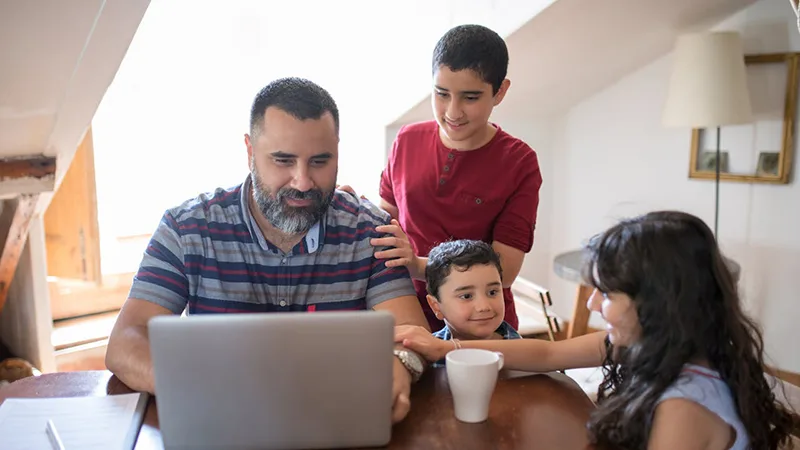This article is about parenting in the digital world and how to raise children in today's connected era.The landscape of modern parenting has transformed dramatically in recent years. As a tech-savvy generation navigates family life, we’ve witnessed firsthand how digital transformation has reshaped our daily routines and interactions. Every day brings new opportunities and challenges, from managing healthy screen time habits to helping children navigate the endless stream of content at their fingertips. While many parents feel overwhelmed by the pace of technological change, finding the right balance isn’t about being perfect—it’s about being present and adaptable. In today’s world of digital family management, success comes from understanding both the challenges and opportunities that technology presents in our children’s lives.
Table of Contents

Understanding Parenting in the Digital World
Understanding how children naturally interact with technology helps us better support their digital journey. Unlike previous generations who had to adapt to new technologies, today’s children are born into a world where digital interaction is as natural as face-to-face communication. Let’s explore how this fundamental difference shapes their development and our approach to parenting.
How Technology and Parenting Intersect Today
The reality of childhood in the digital age looks drastically different from previous generations. Today’s children experience a world where digital literacy is as fundamental as reading and writing. When a toddler instinctively swipes a picture book or a preschooler navigates a tablet more efficiently than their grandparents, we witness firsthand how early digital exposure shapes modern childhood experiences.
Essential Digital Parenting Tips
Modern children approach technology with an intuitive understanding that often surprises adults. While parents might see digital devices as tools or entertainment, children view them as integral parts of their daily experience. In classrooms and homes around the world, educational technology seamlessly blends with traditional learning methods. A first-grader might naturally switch between physical blocks and digital coding games, developing both spatial awareness and computational thinking skills simultaneously. Children actively engage with digital content not just as consumers but as creators, using tablets to draw, compose music, or create simple animations.
Adapting to the Digital Era
The contrast between past and present childhood experiences extends far beyond obvious technological advances. Where previous generations experienced clear boundaries between different aspects of life—school, home, social activities—today’s children live in a world where these boundaries are increasingly fluid. A child might attend a virtual museum tour in the morning, collaborate on a digital school project with classmates in the afternoon, and enjoy a video call with relatives in the evening, all while developing essential digital communication skills.
As we understand how deeply technology integrates into children’s lives, the question of screen time naturally emerges as a primary concern for modern families. Let’s explore how to approach this challenge thoughtfully and practically.

Screen Time and Digital Balance
Moving beyond simple time limits, modern families need strategies for making screen time meaningful and manageable. The key lies not in restricting digital access entirely, but in creating thoughtful approaches that maximize benefits while minimizing potential drawbacks. Here’s how successful families navigate this common challenge.
How to Set Screen Time Limits Effectively
Perhaps no other aspect of modern family life generates more discussion and concern than screen time. Parents often worry about achieving perfect screen time balance, but successful families focus instead on the quality of digital engagement. For instance, thirty minutes spent creating digital art or learning coding basics often provides more value than two hours of passive video watching.
Screen Time Parental Control Options
Establishing effective screen limits requires a nuanced approach that considers age, maturity level, and individual family circumstances. Rather than implementing rigid rules, successful families create what we might call smart digital boundaries. For example, designating the dining room as a tech-free zone naturally encourages family conversation during meals. Similarly, establishing a “screens off one hour before bedtime” routine helps children develop healthy sleep hygiene habits while using the time for family reading or conversation.
When it comes to gaming, many parents worry about potential negative effects. However, recent research has shown numerous benefits of gaming when properly managed. My comprehensive guide on video game benefits explores how gaming can improve cognitive skills, social connections, and even professional development.
Surprising Science: Video Games Are Good For You
Discover why video games are good for your brain, social skills, and future. Science reveals surprising benefits of gaming backed by research.
Creating Healthy Digital Boundaries
The key difference lies in understanding passive versus active screen time. When children use technology for creative digital activities like building virtual worlds in educational games, designing simple websites, or creating digital stories, they develop valuable skills. Many families find success with “tech project time” where children use devices for specific creative goals, such as making a digital family newsletter or learning photography through guided photo challenges.
While understanding healthy screen time usage forms an essential foundation, ensuring our children’s safety in digital spaces becomes the next crucial consideration for modern parents.

Internet Safety for Parents
Safety in the digital world requires a combination of practical guidelines and ongoing dialogue. Rather than relying solely on technical solutions, effective online protection starts with teaching children to think critically about their digital interactions and make smart choices online. Let’s explore strategies that help build both safety skills and confidence.
Internet Safety for Kids
The topic of online child safety often feels overwhelming for parents. Instead of relying solely on technical solutions, successful families focus on developing what we might call digital street smarts. This involves teaching children to recognize and respond to online risks just as they would learn to navigate physical-world safety. For instance, families might practice scenarios about handling unexpected friend requests or discussing what information should never be shared online.
Online Safety Tips for Parents
Teaching digital privacy becomes more effective when connected to real-world examples. Smart parents use everyday situations to illustrate online safety principles. They might compare password protection to house keys, explaining how we don’t share our house keys with friends, just as we don’t share our passwords. Or they might relate digital footprints to leaving tracks in the sand – explaining how online actions leave traces that others can follow.
Managing Digital Purchases and Security
Teaching children about responsible digital consumption includes understanding online purchases and app store safety. Despite our best precautions, accidents can happen. If you’re facing unexpected charges, learn about Easy Fixes When Your Kid Makes an Unauthorized Purchase to resolve the situation quickly and implement better safeguards for the future.
Easy Fixes When Your Kid Makes an Unauthorized Purchase
A parent’s guide to managing unauthorized purchases online. Learn security steps, prevention tools, and teaching moments from real experience.
Internet Safety for Families
Successful family online safety approaches involve regular, open discussions rather than one-time conversations. Many families implement a “tech talk Tuesday” tradition where they discuss recent online experiences, share potential concerns, and celebrate positive digital citizenship moments. This ongoing dialogue helps children feel comfortable reporting problems and seeking guidance when needed.
With a solid foundation in safety, families can fully explore the incredible learning opportunities that technology offers in today’s connected world.

Digital Learning and Development
When thoughtfully approached, technology becomes a powerful tool for expanding children’s educational horizons. Today’s digital learning landscape offers unprecedented opportunities for personalized education and skill development. Understanding how to harness these tools effectively can transform screen time into valuable learning experiences.
Finding Quality Digital Learning
The landscape of educational technology offers unprecedented opportunities for personalized learning. Successful families approach digital education as a complement to traditional learning rather than a replacement. For example, a child struggling with mathematics might use interactive apps that present concepts visually, while still practicing with physical manipulatives. Parents report success with “learning stations” at home that combine both digital and traditional tools for subjects like reading, writing, and mathematics.
Making Learning Interactive
The most effective digital learning experiences often involve active participation and real-world connections. Families find success with approaches that blend technology with hands-on activities. A child interested in birds might use a bird identification app during nature walks, photograph their findings, and create a digital nature journal. This combination of technology-enhanced learning with real-world exploration deepens understanding and maintains engagement.
Supporting Passion Projects
One of the most powerful aspects of digital learning tools lies in their ability to support children’s unique interests. When a child shows curiosity about any topic, from astronomy to zoology, digital resources can help them explore at their own pace. Parents share success stories of children using educational platforms to learn coding, create digital art, or even start simple blogs about their interests.
As children develop their learning skills through technology, they naturally begin to explore social connections in digital spaces, presenting both opportunities and challenges for modern families.

Social Media Safety for Parents and Teens
Digital spaces have become essential venues for social interaction among young people. Understanding how children build and maintain relationships through digital communication helps parents support healthy social development across both online and offline environments. Let’s examine how to guide positive social connections in the digital age.
Social Media Safety Tips for Parents
The distinction between physical and virtual friendships continues to evolve in today’s interconnected world. Modern social connection patterns show children forming meaningful relationships through both in-person and digital interactions. For instance, a child might strengthen school friendships through shared online gaming sessions, or maintain connections with former classmates who have moved away through monitored video chat platforms. Understanding these hybrid friendships helps parents provide appropriate support and guidance.
Understanding Teen Social Media Use
Teaching online empathy requires new approaches in the digital age. Successful families often use real-world scenarios to illustrate the impact of online actions. For example, parents might ask children to imagine how their friend would feel reading a comment before posting it, or discuss how sharing or excluding others from online groups affects real feelings. These conversations about digital social awareness help children develop stronger emotional intelligence in online spaces.
Parental Online Monitoring Strategies
Modern social media literacy extends beyond basic safety rules to include complex social navigation skills. Parents find success in teaching healthy online interaction through guided practice. This might involve role-playing common social media situations, discussing examples of both positive and problematic online behaviors, or creating family guidelines for digital communication etiquette. Many families establish “social media mentoring” time where parents and children explore online platforms together, discussing various scenarios and appropriate responses.
While children navigate their social connections online, maintaining strong family bonds becomes even more crucial in the digital age.

Building Digital Family Connections
Technology can either strengthen or strain family bonds, depending on how we use it. Finding ways to leverage digital connectivity while preserving meaningful face-to-face interactions helps families thrive in the modern age. Here’s how to create a balanced approach to family connection in the digital era.
Creating Digital Family Traditions
In an era of constant connectivity, successful families establish what we might call digital family rituals. These could include weekly virtual family game nights that include distant relatives, creating collaborative family digital albums, or maintaining a private family blog where everyone shares their daily highlights. Some families report success with “tech time together” sessions where family members take turns sharing their favorite apps or teaching others new digital skills.
Family Gaming: Quality Digital Time
While technology can sometimes create distance, choosing the right digital activities can bring families closer together. Looking for ways to make screen time more engaging for everyone? Check out our guide to 7 Must-Try Kids Games That Parents Will Actually Love that can transform ordinary screen time into memorable family moments. These carefully selected games offer opportunities for cooperation, learning, and genuine family fun that bridges the generational digital divide.
7 Must-Try Kids Games That Parents Will Actually Love
Discover how kids games can strengthen family bonds. A parent’s guide to 7 amazing co-op games that both children and adults will love.
Balancing Connection Methods
Modern technology offers unprecedented opportunities for family digital engagement. Successful families often create a mix of digital and traditional connection points throughout the day. For example, using quick video messages to share exciting moments during the day, while maintaining device-free dinner conversations to discuss those moments in depth. Some families implement “connection corners” in their homes where they place both traditional family games and devices for family-friendly digital activities.
Preserving Unplugged Moments
While embracing technology’s benefits, establishing strong tech-free family time remains crucial. Successful families create what we might call digital sanctuary spaces within their homes and routines. This could mean Saturday morning pancake breakfasts where devices stay in another room, weekly family walks where phones are used only for taking nature photos, or evening reading times where paper books take priority over tablets.
Understanding how technology affects our children’s emotional well-being becomes essential as we navigate these various aspects of digital family life.

Emotional Wellbeing in the Digital Era
The psychological effects of growing up in a digitally connected world present unique challenges and opportunities for emotional development. Understanding how digital experiences influence children’s emotional well-being helps parents provide better support and guidance. Let’s explore strategies for fostering healthy emotional growth in the digital age.
Understanding Digital Emotions
The relationship between digital consumption and emotional well-being requires careful attention in modern parenting. Children often experience what we might call digital emotional overload from constant connection and information flow. Successful families implement regular “emotional check-ins” about digital experiences, helping children recognize how different online activities affect their mood and energy levels.
Building Digital Resilience
Developing strong emotional resilience in the digital world involves helping children maintain perspective about online experiences. Parents find success in teaching children to distinguish between their online presence and their real-world value. For example, families might create “confidence journals” where children record their achievements and positive experiences in both digital and physical realms, helping them maintain balanced self-esteem.
Creating Emotional Balance
Supporting healthy digital wellness involves establishing regular practices for emotional regulation. Successful families often create what we call digital reset routines – specific activities that help children transition between online and offline experiences. This might include physical exercise after gaming sessions, creative arts after social media use, or quiet reading time after watching videos.

Digital Parenting: Conclusion
The journey of raising digital natives requires continuous adaptation and learning, but certain principles remain constant. Successful digital age parenting combines traditional wisdom with modern approaches to create balanced, healthy relationships with technology. Through thoughtful implementation of family technology strategies, consistent communication, and regular adaptation of approaches as children grow, we can help our children develop into capable digital citizens who use technology as a tool for growth rather than a source of limitation.
Remember that every family’s journey with technology will look different, and what works today may need adjustment tomorrow. The goal isn’t perfection in digital family management but rather creating a sustainable approach that promotes healthy development, strong family connections, and positive technology use for everyone involved.
Frequently Asked Questions About Digital Parenting
How do I know if my child is spending too much time on screens?
Rather than focusing solely on time, evaluate the quality of digital engagement. Watch for signs that screen time interferes with sleep, physical activity, schoolwork, or in-person social interactions. Healthy screen time balance varies by age and individual needs. If your child maintains good grades, participates in offline activities, and shows positive behavior, their screen time may be appropriate. However, if you notice mood changes, sleep issues, or resistance to non-digital activities, it might be time to adjust their digital consumption habits.
What age should children start using social media?
The appropriate age for social media introduction depends on your child’s maturity level and ability to understand online privacy. Most platforms set their minimum age at 13, but readiness involves more than age. Consider whether your child can grasp concepts like digital footprints, online privacy, and social responsibility. Start with family-oriented platforms or supervised accounts to teach responsible social media use before allowing independent access.
How can I protect my child from inappropriate online content?
Creating a safe digital environment requires multiple strategies. Implement appropriate parental controls and content filters, but focus equally on developing your child’s critical thinking skills. Teach them about safe browsing habits, encourage open communication about online experiences, and create family guidelines for acceptable content. Remember that building digital resilience is as important as using technical safeguards.
What’s the best way to handle my child’s gaming habits?
Approach gaming management by understanding the types of games your child plays and their social aspects. Set clear expectations about when gaming fits into the daily routine, encourage balanced gaming habits, and look for games that offer educational or social benefits. Consider using gaming as family bonding time through cooperative gaming sessions, and establish clear guidelines about in-game purchases and online interactions.
How can technology support my child’s learning?
Maximize educational technology benefits by aligning digital tools with your child’s learning style and interests. Look for interactive learning platforms that provide feedback and track progress. Combine digital learning with hands-on activities, and use technology to explore subjects in depth. Remember that effective digital education often involves parent participation and guidance, especially in the beginning.
What should I do if I discover my child having negative online experiences?
Stay calm and maintain open communication about online challenges. Listen without judgment to understand the situation fully. Address immediate safety concerns through appropriate digital safety measures, but also use the experience as a teaching opportunity. Help your child develop strategies for handling similar situations in the future, and consider whether additional online safety education would be beneficial.
How can I model good technology habits for my children?
Practice mindful technology use by setting clear boundaries for your own device time. Demonstrate healthy digital wellness habits like avoiding phones during meals, maintaining tech-free times, and balancing online and offline activities. Share your own strategies for managing digital distractions and show how technology can be used productively while maintaining personal connections.
What are the signs that my child might be experiencing digital stress?
Watch for changes in behavior or mood related to online activities. Signs of digital overwhelm might include anxiety about social media responses, difficulty transitioning between digital and real-world activities, or emotional outbursts when device time ends. Pay attention to sleep patterns, social interactions, and general mood. If you notice consistent issues, consider implementing additional digital wellness strategies and possibly consulting with professionals who understand modern childhood challenges.
Want more insights like this? Subscribe to my newsletter for weekly updates!





